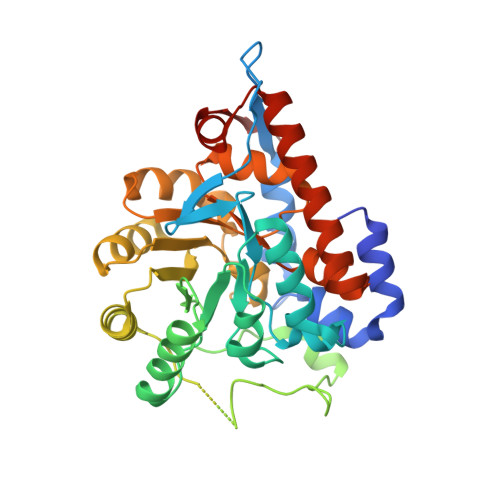Structural and chemical trapping of flavin-oxide intermediates reveals substrate-directed reaction multiplicity.
Lin, K.H., Lyu, S.Y., Yeh, H.W., Li, Y.S., Hsu, N.S., Huang, C.M., Wang, Y.L., Shih, H.W., Wang, Z.C., Wu, C.J., Li, T.L.(2020) Protein Sci 29: 1655-1666
- PubMed: 32362037
- DOI: https://doi.org/10.1002/pro.3879
- Primary Citation of Related Structures:
5ZZT, 6A01, 6A0B, 6A1B, 6A1N, 6A1W, 6A24, 6A36, 6A3D, 6A4G, 6A4H, 7BSR - PubMed Abstract:
Though reactive flavin-N5/C4¦Á-oxide intermediates can be spectroscopically profiled for some flavin-assisted enzymatic reactions, their exact chemical configurations are hardly visualized. Structural systems biology and stable isotopic labelling techniques were exploited to correct this stereotypical view. Three transition-like complexes, the ¦Á-ketoacid¡N5-FMN ox complex (I), the FMN ox -N5-aloxyl-C'¦Á - -C4¦Á + zwitterion (II), and the FMN-N5-ethenol-N5-C4¦Á-epoxide (III), were determined from mandelate oxidase (Hmo) or its mutant Y128F (monooxygenase) crystals soaked with monofluoropyruvate (a product mimic), establishing that N5 of FMN ox an alternative reaction center can polarize to an ylide-like mesomer in the active site. In contrast, four distinct flavin-C4¦Á-oxide adducts (IV-VII) from Y128F crystals soaked with selected substrates materialize C4¦Á of FMN an intrinsic reaction center, witnessing oxidation, Baeyer-Villiger/peroxide-assisted decarboxylation, and epoxidation reactions. In conjunction with stopped-flow kinetics, the multifaceted flavin-dependent reaction continuum is physically dissected at molecular level for the first time.
Organizational Affiliation:
Genomics Research Center, Academia Sinica, Taipei, Taiwan.


















